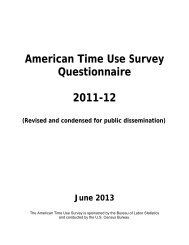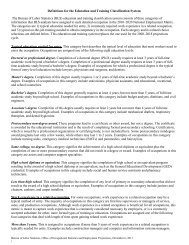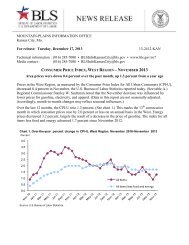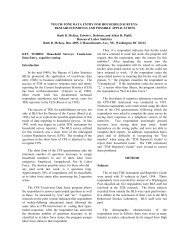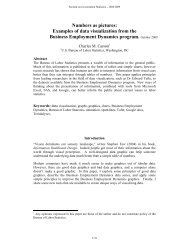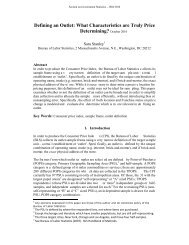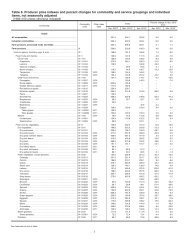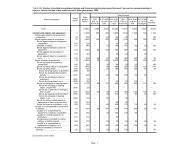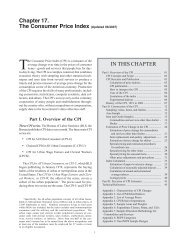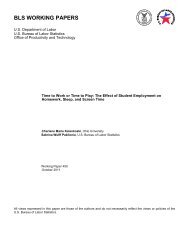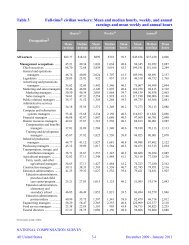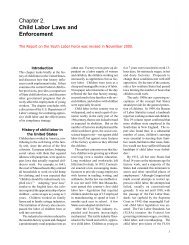Household spending by single persons and married couples in their ...
Household spending by single persons and married couples in their ...
Household spending by single persons and married couples in their ...
Create successful ePaper yourself
Turn your PDF publications into a flip-book with our unique Google optimized e-Paper software.
WILLIAM HAWK<br />
William Hawk is an economist <strong>in</strong> the Branch<br />
of Information <strong>and</strong> Analysis, Division of Consumer<br />
Expenditure Survey, Bureau of Labor<br />
Statistics.<br />
<strong>Household</strong> <strong>spend<strong>in</strong>g</strong><br />
<strong>by</strong> <strong>s<strong>in</strong>gle</strong> <strong>persons</strong> <strong>and</strong><br />
<strong>married</strong> <strong>couples</strong> <strong>in</strong> <strong>their</strong><br />
twenties: a comparison<br />
In the United States, <strong>persons</strong> reach<strong>in</strong>g<br />
age 21 enter adulthood fac<strong>in</strong>g<br />
the challenges <strong>and</strong> opportunities<br />
that come with personal <strong>and</strong> economic<br />
autonomy. Young adults <strong>in</strong> <strong>their</strong> twenties<br />
traditionally are complet<strong>in</strong>g <strong>their</strong><br />
educational goals, enter<strong>in</strong>g the workforce,<br />
<strong>and</strong> mak<strong>in</strong>g decisions regard<strong>in</strong>g<br />
marriage <strong>and</strong> liv<strong>in</strong>g arrangements. An<br />
earlier Consumer Expenditure Survey<br />
Anthology article <strong>by</strong> Geoffrey Paul<strong>in</strong><br />
noted the relevance of study<strong>in</strong>g <strong>persons</strong><br />
<strong>in</strong> <strong>their</strong> twenties. 1 In the article,<br />
Paul<strong>in</strong> <strong>in</strong>vestigated the <strong>spend<strong>in</strong>g</strong> habits<br />
of never-<strong>married</strong> <strong>s<strong>in</strong>gle</strong>s ages 21 to 29<br />
years <strong>and</strong> noted that “For many Americans,<br />
the age of 21 is a major po<strong>in</strong>t of<br />
demarcation <strong>in</strong> one’s life cycle.”<br />
Published Consumer Expenditure<br />
Survey (CE) data <strong>in</strong>dicate that, compared<br />
with average U.S. consumer<br />
units (CUs), those headed <strong>by</strong> <strong>persons</strong><br />
25 years or younger earn lower <strong>in</strong>comes,<br />
are less likely to own a home<br />
or a car, <strong>and</strong> spend less on food, gifts,<br />
health care, <strong>and</strong> retirement plans.<br />
They are also more likely to rent<br />
a home <strong>and</strong> spend more on education<br />
<strong>and</strong> alcohol. 2<br />
The analysis that follows exam<strong>in</strong>es<br />
demographic characteristics, per-<br />
1 Geoffrey Paul<strong>in</strong>, “Exam<strong>in</strong><strong>in</strong>g Expenditure<br />
Patterns of Young S<strong>in</strong>gle Adults <strong>in</strong> a Historical<br />
Context: Two Recent Generations Compared,”<br />
Consumer Expenditure Survey Anthology, 2008<br />
(U.S. Bureau of Labor Statistics, December<br />
2008).<br />
2 See “Table 3. Age of reference person,” on<br />
the Internet at http://www.bls.gov/cex/2008/<br />
St<strong>and</strong>ard/age.pdf.<br />
capita <strong>in</strong>comes, <strong>and</strong> <strong>spend<strong>in</strong>g</strong> patterns<br />
of <strong>s<strong>in</strong>gle</strong> <strong>and</strong> <strong>married</strong> <strong>persons</strong> <strong>in</strong> <strong>their</strong><br />
twenties. The first section explores how<br />
these characteristics, with<strong>in</strong> the <strong>s<strong>in</strong>gle</strong><br />
<strong>and</strong> <strong>married</strong> categories, differ from the<br />
early twenties to the late twenties. The<br />
second section explores <strong>in</strong>come <strong>and</strong><br />
<strong>spend<strong>in</strong>g</strong> differences between <strong>s<strong>in</strong>gle</strong>s<br />
<strong>and</strong> <strong>married</strong> <strong>couples</strong>. The analysis uses<br />
2007–08 CE data on <strong>s<strong>in</strong>gle</strong> <strong>persons</strong><br />
ages 21 to 29 years who were never<br />
<strong>married</strong> <strong>and</strong> on <strong>married</strong> <strong>couples</strong> whose<br />
reference person 3 is 21 to 29 years <strong>and</strong><br />
has no children.<br />
The chief f<strong>in</strong>d<strong>in</strong>gs of the study are<br />
as follows:<br />
• S<strong>in</strong>gles <strong>in</strong> <strong>their</strong> late twenties<br />
spend more <strong>and</strong> have a higher<br />
<strong>in</strong>come than <strong>s<strong>in</strong>gle</strong>s <strong>in</strong> <strong>their</strong> early<br />
twenties.<br />
• The average per-capita <strong>in</strong>come of<br />
<strong>s<strong>in</strong>gle</strong>s 21 to 23 years is significantly<br />
lower than that of <strong>married</strong><br />
<strong>couples</strong> <strong>in</strong> the same age range.<br />
The reverse is true of <strong>s<strong>in</strong>gle</strong>s <strong>and</strong><br />
<strong>married</strong> <strong>couples</strong> 27 to 29 years.<br />
• Married <strong>couples</strong> are more likely<br />
than <strong>s<strong>in</strong>gle</strong>s to be homeowners.<br />
• S<strong>in</strong>gles spend significantly more<br />
per capita than <strong>married</strong> <strong>couples</strong><br />
do on food, hous<strong>in</strong>g, apparel,<br />
<strong>and</strong> education, <strong>and</strong> less on health<br />
care.<br />
3 See glossary on page 48 for the BLS def<strong>in</strong>ition<br />
of “reference person.”<br />
Consumer Expenditure Survey Anthology, 2011 40
Data <strong>and</strong> methods<br />
Interview survey. The data for this article<br />
are from the 2007–08 Interview<br />
Survey component of the CE. The Interview<br />
Survey conta<strong>in</strong>s <strong>in</strong>formation<br />
on <strong>in</strong>comes, expenditures, <strong>and</strong> demographic<br />
characteristics of American<br />
consumers, collected quarterly from<br />
a nationally representative sample of<br />
CUs <strong>in</strong> the U.S. population.<br />
The CE <strong>in</strong>cludes two components:<br />
the quarterly Interview Survey <strong>and</strong><br />
the weekly Diary Survey. Published<br />
CE tables are created <strong>by</strong> <strong>in</strong>tegrat<strong>in</strong>g<br />
<strong>in</strong>formation from the two surveys.<br />
The Interview Survey, which is designed<br />
to collect data on major types<br />
of expenditures, household characteristics,<br />
<strong>and</strong> <strong>in</strong>come, is used <strong>in</strong> this study<br />
because it provides the most complete<br />
picture of <strong>spend<strong>in</strong>g</strong>. Respondents are<br />
usually asked to report values for<br />
expenditures or outlays that occurred<br />
dur<strong>in</strong>g the three months prior to the<br />
<strong>in</strong>terview. The data <strong>in</strong> this analysis<br />
are <strong>by</strong> collection year, not calendar<br />
year, from CUs <strong>in</strong>terviewed <strong>in</strong> 2007<br />
<strong>and</strong> 2008. This study employs many<br />
of the methods set forth <strong>in</strong> Paul<strong>in</strong>’s<br />
article.<br />
Outlays. The analysis that follows<br />
uses outlays, as opposed to expenditures,<br />
for comparisons. Outlays are<br />
similar to expenditures <strong>in</strong> that both<br />
measures (1) def<strong>in</strong>e <strong>spend<strong>in</strong>g</strong> as the<br />
transaction cost, <strong>in</strong>clud<strong>in</strong>g taxes, to<br />
obta<strong>in</strong> goods <strong>and</strong> services, (2) <strong>in</strong>clude<br />
<strong>spend<strong>in</strong>g</strong> on gifts for people outside<br />
of the CU, <strong>and</strong> (3) exclude bus<strong>in</strong>ess<br />
expenses. The key difference is <strong>in</strong><br />
the treatment of purchases of real<br />
property <strong>and</strong> vehicles. In the CE, expenditures<br />
on purchases of property<br />
<strong>in</strong>clude only mortgage <strong>in</strong>terest <strong>and</strong><br />
expenditures on vehicles <strong>in</strong>clude the<br />
full value of the purchased vehicle,<br />
regardless of whether it was or was<br />
not f<strong>in</strong>anced. By contrast, outlays<br />
<strong>in</strong>clude both the pr<strong>in</strong>cipal <strong>and</strong> <strong>in</strong>terest<br />
portions of property on mortgages<br />
<strong>and</strong> vehicle loans. The purchase price<br />
of vehicles bought outright <strong>and</strong> not<br />
f<strong>in</strong>anced also is <strong>in</strong>cluded <strong>in</strong> outlays.<br />
Weights. The CE uses a representative<br />
sample to estimate the <strong>spend<strong>in</strong>g</strong> habits<br />
of the U.S. civilian non<strong>in</strong>stitutional<br />
population. Estimates shown <strong>in</strong> this<br />
article are calculated with the use of<br />
weights. For the 2007–08 Interview<br />
Survey, approximately 600 <strong>married</strong><br />
CUs <strong>and</strong> 2,200 <strong>s<strong>in</strong>gle</strong> CUs provided<br />
data for this analysis. These sampled<br />
CUs represent nearly 7 million CUs<br />
<strong>in</strong> the population.<br />
Reference groups. Recogniz<strong>in</strong>g that<br />
21- to 29-year-olds are not a homogeneous<br />
group <strong>and</strong> that the twenties<br />
are a period of lifestyle transition,<br />
the analysis exam<strong>in</strong>es three dist<strong>in</strong>ct<br />
groups: those CUs (with reference<br />
person) ages 21 to 23 years, those <strong>in</strong><br />
<strong>their</strong> midtwenties (24 to 26 years),<br />
<strong>and</strong> those <strong>in</strong> <strong>their</strong> late twenties (27 to<br />
29 years). Further restrictions on the<br />
age difference between spouses <strong>in</strong> a<br />
<strong>married</strong>-couple CU follow.<br />
Consumers must be <strong>s<strong>in</strong>gle</strong> or <strong>married</strong><br />
with no children <strong>in</strong> order to be<br />
<strong>in</strong>cluded <strong>in</strong> the analysis. To be categorized<br />
as a “<strong>s<strong>in</strong>gle</strong>” CU, a person must<br />
identify him- or herself as <strong>s<strong>in</strong>gle</strong> <strong>and</strong><br />
never <strong>married</strong> <strong>and</strong> must be <strong>in</strong> a CU<br />
of size 1. This categorization implies<br />
that the person is not liv<strong>in</strong>g with<br />
other blood relatives, is not widowed<br />
or divorced, <strong>and</strong>, if there are other<br />
people liv<strong>in</strong>g <strong>in</strong> the hous<strong>in</strong>g unit, is<br />
f<strong>in</strong>ancially <strong>in</strong>dependent (that is, is<br />
not mak<strong>in</strong>g jo<strong>in</strong>t f<strong>in</strong>ancial decisions<br />
with his or her housemates). F<strong>in</strong>ancial<br />
<strong>in</strong>dependence is determ<strong>in</strong>ed <strong>by</strong><br />
the three major expense categories:<br />
hous<strong>in</strong>g, food, <strong>and</strong> other liv<strong>in</strong>g expenses.<br />
To be considered f<strong>in</strong>ancially<br />
<strong>in</strong>dependent, the respondent must<br />
pay all or part of the consumer unit’s<br />
expenses <strong>in</strong> at least two of the three<br />
major expense categories.<br />
Examples of <strong>s<strong>in</strong>gle</strong>s eligible for<br />
this study <strong>in</strong>clude a 25-year-old liv<strong>in</strong>g<br />
with three of her friends who<br />
makes her own f<strong>in</strong>ancial decisions<br />
<strong>and</strong> a 21-year-old resid<strong>in</strong>g <strong>in</strong> a college<br />
dormitory even if he receives<br />
money from his parents each month.<br />
In contrast, a 27-year-old liv<strong>in</strong>g at<br />
home with his parents is not counted<br />
as <strong>s<strong>in</strong>gle</strong> even if he is f<strong>in</strong>ancially<br />
<strong>in</strong>dependent.<br />
For the <strong>married</strong> group, each CU<br />
must, of course, be <strong>married</strong> <strong>and</strong> must<br />
be liv<strong>in</strong>g <strong>in</strong> a two-member CU. In<br />
order to allow for closer comparisons<br />
between <strong>s<strong>in</strong>gle</strong>s <strong>and</strong> <strong>couples</strong> <strong>in</strong> the<br />
same age group, <strong>couples</strong> with age differences<br />
greater than 4 years between<br />
<strong>their</strong> members are omitted from <strong>their</strong><br />
respective groups.<br />
An example of a <strong>married</strong> couple<br />
eligible for the study is a <strong>married</strong><br />
couple, one member of whom is age<br />
27, <strong>and</strong> the other age 31, with no<br />
children. The same couple would be<br />
eligible even if the pair rented out<br />
<strong>their</strong> basement to another family. By<br />
contrast, any couple whose members<br />
Groups eligible to participate <strong>in</strong> the study<br />
S<strong>in</strong>gle<br />
Ages: 21–23; 24–26; 27–29<br />
CU type: <strong>s<strong>in</strong>gle</strong> <strong>persons</strong><br />
CU size: 1<br />
Marital status: <strong>s<strong>in</strong>gle</strong>, never <strong>married</strong><br />
Married<br />
Age of reference person: 21–23; 24–26; 27–29<br />
Age of spouse: with<strong>in</strong> 4 years of age of reference person<br />
CU type: husb<strong>and</strong> <strong>and</strong> wife only<br />
CU size: 2<br />
Marital status: <strong>married</strong>, no children<br />
Consumer Expenditure Survey Anthology, 2011 41
are, respectively, 22 <strong>and</strong> 27 years<br />
would not be eligible, because <strong>their</strong><br />
ages differ <strong>by</strong> more than 4 years.<br />
Also <strong>in</strong>eligible is a couple liv<strong>in</strong>g <strong>in</strong><br />
the home of the reference person’s<br />
parents, regardless of the members’<br />
ages <strong>and</strong> f<strong>in</strong>ancial <strong>in</strong>dependence.<br />
Results are from the eligibility classification<br />
used <strong>and</strong> were computed on<br />
a per-capita basis, unless explicitly<br />
stated otherwise. This approach allows<br />
for closer comparisons between <strong>s<strong>in</strong>gle</strong>s<br />
<strong>and</strong> <strong>couples</strong>.<br />
Early twenties compared with<br />
late twenties<br />
S<strong>in</strong>gles. Sixty-seven percent of <strong>s<strong>in</strong>gle</strong>s<br />
<strong>in</strong> <strong>their</strong> early twenties (21 to 23 years)<br />
are enrolled <strong>in</strong> college either full or<br />
part time, 18 percent have earned a<br />
bachelor’s degree, <strong>and</strong> 6 percent report<br />
own<strong>in</strong>g a home. (See chart 1.)<br />
S<strong>in</strong>gles <strong>in</strong> <strong>their</strong> early twenties<br />
tend to spend more money, on average,<br />
than they earn per year. Table 1<br />
shows that average reported outlays<br />
of 21- to 23-year-olds exceed average<br />
<strong>in</strong>come <strong>by</strong> about $5,000 ($21,083 <strong>and</strong><br />
$16,067).<br />
Lend<strong>in</strong>g credence to the view that<br />
<strong>s<strong>in</strong>gle</strong>s <strong>in</strong> <strong>their</strong> twenties are <strong>in</strong> a transitional<br />
period, more of those <strong>in</strong> <strong>their</strong><br />
late twenties have bought a home or<br />
earned a bachelor’s degree. Thirty-five<br />
percent of <strong>s<strong>in</strong>gle</strong>s ages 27 to 29 years<br />
report own<strong>in</strong>g a home, 55 percent have<br />
earned a bachelor’s degree, <strong>and</strong> 18<br />
percent are enrolled <strong>in</strong> college either<br />
part time or full time.<br />
The average <strong>in</strong>come of a late-twenties<br />
<strong>s<strong>in</strong>gle</strong>, $39,757, is almost 2½ times<br />
that of an early-twenties <strong>s<strong>in</strong>gle</strong>, <strong>and</strong> the<br />
average total outlay of a late-twenties<br />
<strong>s<strong>in</strong>gle</strong>, $34,889, is well above that of<br />
an early-twenties <strong>s<strong>in</strong>gle</strong>. Late-twenties<br />
<strong>s<strong>in</strong>gle</strong>s outspend early-twenties <strong>s<strong>in</strong>gle</strong>s<br />
<strong>in</strong> every expenditure category except<br />
education.<br />
There are also differences <strong>in</strong> how<br />
<strong>s<strong>in</strong>gle</strong>s allocate <strong>their</strong> outlays. Earlytwenties<br />
<strong>s<strong>in</strong>gle</strong>s spend a larger share<br />
of <strong>their</strong> budgets on food <strong>and</strong> education<br />
<strong>and</strong> a smaller share on hous<strong>in</strong>g <strong>and</strong><br />
transportation than do late-twenties<br />
<strong>s<strong>in</strong>gle</strong>s. Food accounts for 18.0 per-<br />
cent, <strong>and</strong> education 11.0 percent, of<br />
outlays for an early-twenties <strong>s<strong>in</strong>gle</strong>,<br />
whereas food accounts for only 14.6<br />
percent, <strong>and</strong> education 1.6 percent,<br />
for a late-twenties <strong>s<strong>in</strong>gle</strong>. Hous<strong>in</strong>g<br />
accounts for 34.5 percent, <strong>and</strong> transportation<br />
14.2 percent, of outlays for an<br />
early-twenties <strong>s<strong>in</strong>gle</strong>; hous<strong>in</strong>g makes<br />
up 39.0 percent, <strong>and</strong> transportation<br />
16.6 percent, of outlays for a latetwenties<br />
<strong>s<strong>in</strong>gle</strong>.<br />
Married <strong>couples</strong>. For <strong>married</strong> CUs<br />
with reference person ages 21 to 23<br />
years, 17 percent report own<strong>in</strong>g a<br />
home, 21 percent have at least one<br />
person with a bachelor’s degree, <strong>and</strong><br />
46 percent have at least one person<br />
enrolled <strong>in</strong> college either part or full<br />
time. (See chart 2.) Average per-capita<br />
<strong>in</strong>come is $22,986 <strong>and</strong> average percapita<br />
total outlays are $20,120. (See<br />
table 1.)<br />
The twenties are also a transitional<br />
age for <strong>couples</strong>. Of <strong>married</strong> <strong>couples</strong><br />
with reference person ages 27 to 29<br />
years, 69 percent report own<strong>in</strong>g <strong>their</strong><br />
home, 73 percent live <strong>in</strong> a CU with<br />
at least one person with a bachelor’s<br />
degree, <strong>and</strong> 29 percent are CUs with at<br />
least one member enrolled <strong>in</strong> college<br />
either part or full time. The average<br />
per-capita <strong>in</strong>come of the late-twenties<br />
<strong>married</strong> group, $38,182, is 66 percent<br />
higher than the average per-capita<br />
<strong>in</strong>come of the early-twenties <strong>married</strong><br />
group, whereas average per-capita<br />
total outlays of late-twenties <strong>married</strong><br />
<strong>couples</strong>, $26,649, are 32 percent higher<br />
than those of early-twenties <strong>married</strong><br />
<strong>couples</strong>.<br />
Early-twenties <strong>couples</strong> spend a<br />
larger share of <strong>their</strong> budgets on food,<br />
transportation, <strong>and</strong> enterta<strong>in</strong>ment, <strong>and</strong><br />
a smaller share on hous<strong>in</strong>g, than do<br />
late-twenties <strong>couples</strong>. Food accounts<br />
for 15.4 percent, transportation 21.3<br />
percent, <strong>and</strong> enterta<strong>in</strong>ment 6.5 percent<br />
of total outlays for an early-twenties<br />
couple, whereas food accounts for 13.6<br />
percent, transportation 19.5 percent,<br />
<strong>and</strong> enterta<strong>in</strong>ment 5.4 percent for a<br />
late-twenties couple. Hous<strong>in</strong>g constitutes<br />
30.0 percent of outlays for an<br />
early-twenties couple, compared with<br />
35.6 percent for a late-twenties couple.<br />
S<strong>in</strong>gles compared with <strong>married</strong><br />
<strong>couples</strong><br />
Demographics. For the comb<strong>in</strong>ed<br />
<strong>s<strong>in</strong>gle</strong> <strong>and</strong> <strong>married</strong>-couple groups<br />
ages 21 to 29 years, <strong>married</strong> <strong>couples</strong><br />
are far more likely than <strong>s<strong>in</strong>gle</strong>s to be<br />
homeowners. The statistics show that<br />
55 percent of <strong>married</strong> <strong>couples</strong> report<br />
own<strong>in</strong>g <strong>their</strong> homes <strong>and</strong> 84 percent of<br />
<strong>s<strong>in</strong>gle</strong>s are renters. Sixty-one percent<br />
of <strong>married</strong> CUs <strong>and</strong> 39 percent of<br />
<strong>s<strong>in</strong>gle</strong> CUs, have at least one member<br />
with a bachelor’s degree, <strong>and</strong> 39 percent<br />
of <strong>married</strong> CUs, compared with 43<br />
percent of <strong>s<strong>in</strong>gle</strong> CUs have at least one<br />
member currently enrolled <strong>in</strong> college.<br />
The difference <strong>in</strong> home ownership<br />
rates of <strong>s<strong>in</strong>gle</strong>s <strong>and</strong> <strong>married</strong> <strong>couples</strong> is<br />
the smallest for 21- to 23-year-olds,<br />
compared with 27- to 29-year-olds. For<br />
the younger group, 6 percent of <strong>s<strong>in</strong>gle</strong>s<br />
<strong>and</strong> 17 percent of <strong>couples</strong> report home<br />
ownership.<br />
The difference <strong>in</strong> home ownership<br />
rates is the largest among 27- to 29-yearolds,<br />
with 69 percent of <strong>married</strong> <strong>couples</strong><br />
report<strong>in</strong>g home ownership, compared<br />
with 35 percent of <strong>s<strong>in</strong>gle</strong>s.<br />
For the 21- to 23-year-olds, 67<br />
percent of <strong>s<strong>in</strong>gle</strong>s report that they are<br />
enrolled <strong>in</strong> college <strong>and</strong> 46 percent<br />
of <strong>couples</strong> report hav<strong>in</strong>g at least one<br />
member enrolled <strong>in</strong> college. Also, 18<br />
percent of <strong>s<strong>in</strong>gle</strong>s have a bachelor’s<br />
degree, <strong>and</strong> 21 percent of <strong>married</strong><br />
<strong>persons</strong> have at least one member<br />
with a bachelor’s degree. For the 27-<br />
to 29-year-olds, 18 percent of <strong>s<strong>in</strong>gle</strong>s<br />
report that they are enrolled <strong>in</strong> college<br />
<strong>and</strong> 29 percent of <strong>married</strong> <strong>persons</strong><br />
report hav<strong>in</strong>g at least one member<br />
enrolled <strong>in</strong> college. Fifty-five percent<br />
of <strong>s<strong>in</strong>gle</strong>s have a bachelor’s degree<br />
or higher, <strong>and</strong> 73 percent of <strong>married</strong><br />
<strong>couples</strong> have at least one member with<br />
a bachelor’s degree or higher.<br />
Income. Married <strong>couples</strong> ages 21 to<br />
29 have <strong>in</strong>comes that are, on average,<br />
$6,779 more than <strong>s<strong>in</strong>gle</strong>s’ <strong>in</strong>comes.<br />
Among <strong>s<strong>in</strong>gle</strong>s, average <strong>in</strong>come is<br />
$16,067 for 21- to 23-year-olds, compared<br />
with $39,757 for 27- to 29-yearolds.<br />
(See chart 3.) Among <strong>married</strong><br />
<strong>couples</strong>, <strong>in</strong>come averages $22,986 for<br />
Consumer Expenditure Survey Anthology, 2011 42
the younger age group, compared with<br />
$38,182 for older <strong>married</strong> <strong>couples</strong>. Differences<br />
<strong>in</strong> <strong>in</strong>come between <strong>s<strong>in</strong>gle</strong>s <strong>and</strong><br />
<strong>married</strong> <strong>couples</strong> are largest <strong>in</strong> the early<br />
twenties ($6,919) <strong>and</strong> smallest <strong>in</strong> the<br />
late twenties ($1,575).<br />
S<strong>in</strong>gles <strong>in</strong> <strong>their</strong> late twenties with at<br />
least a bachelor’s degree or higher earn<br />
$42,645, <strong>and</strong> those <strong>in</strong> <strong>their</strong> late twenties<br />
with a high school diploma or less<br />
earn $26,708. Married <strong>couples</strong> <strong>in</strong> <strong>their</strong><br />
late twenties with at least one member<br />
with a bachelor’s degree or higher earn<br />
$40,240 per capita, <strong>and</strong> late-twenties<br />
<strong>married</strong> <strong>couples</strong> for which the highest<br />
level atta<strong>in</strong>ed <strong>by</strong> either member<br />
is a high school diploma or less earn<br />
$33,169 per capita.<br />
Outlays. For all CUs, ages 21 to 29,<br />
average outlays are similar for <strong>s<strong>in</strong>gle</strong>s<br />
<strong>and</strong> <strong>married</strong> <strong>couples</strong>, with the latter<br />
<strong>spend<strong>in</strong>g</strong> $1,532 less. Differences<br />
<strong>in</strong> outlays between <strong>s<strong>in</strong>gle</strong>s <strong>and</strong> <strong>married</strong><br />
<strong>couples</strong> are smallest <strong>in</strong> the early<br />
twenties ($963) <strong>and</strong> largest <strong>in</strong> the late<br />
twenties ($8,240). (See chart 4.)<br />
Spend<strong>in</strong>g patterns. For the three age<br />
groups comb<strong>in</strong>ed, <strong>s<strong>in</strong>gle</strong>s spend 6<br />
percent more per capita than <strong>married</strong><br />
<strong>couples</strong> spend, but <strong>married</strong> <strong>couples</strong><br />
earn 25 percent more per capita <strong>in</strong><br />
<strong>in</strong>come than <strong>s<strong>in</strong>gle</strong>s earn. Income <strong>and</strong><br />
total outlays, however, tell only part of<br />
the story; a focus on how outlays are<br />
allocated demonstrates the differences<br />
<strong>in</strong> <strong>spend<strong>in</strong>g</strong> patterns of <strong>s<strong>in</strong>gle</strong> <strong>and</strong> <strong>married</strong><br />
consumers.<br />
For all age groups comb<strong>in</strong>ed, <strong>s<strong>in</strong>gle</strong>s<br />
spend a larger share of <strong>their</strong> budget<br />
on food, hous<strong>in</strong>g, <strong>and</strong> education, <strong>and</strong> a<br />
smaller share on transportation <strong>and</strong> on<br />
personal <strong>in</strong>surance <strong>and</strong> pensions, than<br />
do <strong>married</strong> <strong>couples</strong>. Specifically, food<br />
accounts for 16.3 percent, hous<strong>in</strong>g 36.7<br />
percent, <strong>and</strong> education 5.7 percent of<br />
total outlays for <strong>s<strong>in</strong>gle</strong>s, whereas food<br />
accounts for 13.1 percent, hous<strong>in</strong>g<br />
34.5 percent, <strong>and</strong> education 2.4 percent<br />
for <strong>married</strong> <strong>couples</strong>. Transportation<br />
makes up 15.6 percent, <strong>and</strong> personal<br />
<strong>in</strong>surance <strong>and</strong> pensions 8.9 percent, of<br />
total outlays for <strong>s<strong>in</strong>gle</strong>s; transportation<br />
accounts for 20.0 percent, <strong>and</strong> personal<br />
<strong>in</strong>surance <strong>and</strong> pensions 12.7 percent,<br />
for <strong>married</strong> <strong>couples</strong>.<br />
For each age group, some of the<br />
differences <strong>in</strong> <strong>spend<strong>in</strong>g</strong> shares between<br />
<strong>s<strong>in</strong>gle</strong>s <strong>and</strong> <strong>married</strong> <strong>couples</strong> are<br />
more pronounced than for the three<br />
age groups comb<strong>in</strong>ed. Among 21- to<br />
23-year-olds, <strong>s<strong>in</strong>gle</strong>s <strong>and</strong> <strong>married</strong><br />
<strong>couples</strong> allocate <strong>their</strong> <strong>spend<strong>in</strong>g</strong> quite<br />
differently: <strong>s<strong>in</strong>gle</strong>s apportion a higher<br />
percentage of <strong>their</strong> outlays to food, alcohol,<br />
hous<strong>in</strong>g, <strong>and</strong> education, whereas<br />
<strong>married</strong> <strong>couples</strong> apportion a higher<br />
percentage of <strong>their</strong> outlays to transportation,<br />
health care, <strong>and</strong> enterta<strong>in</strong>ment.<br />
The same result holds for the 27- to<br />
29-year age group; however, for most<br />
areas of <strong>spend<strong>in</strong>g</strong>, the difference is<br />
smaller. S<strong>in</strong>gles’ <strong>and</strong> <strong>married</strong> <strong>couples</strong>’<br />
budget shares for food, alcohol, hous<strong>in</strong>g,<br />
transportation, health care, enterta<strong>in</strong>ment,<br />
<strong>and</strong> education are closer to<br />
each other <strong>in</strong> the 27- to 29-year age<br />
group than <strong>in</strong> the 21- to 23-year age<br />
group. In this regard, late-twenties<br />
<strong>s<strong>in</strong>gle</strong>s resemble late-twenties <strong>couples</strong><br />
more than they resemble early-twenties<br />
<strong>s<strong>in</strong>gle</strong>s.<br />
Summary of total outlays<br />
Data from the Interview Survey component<br />
of the CE for 2007–08 show<br />
that ages 21 to 29 years are a time of<br />
transition for young adults. Regardless<br />
of <strong>their</strong> marital status, <strong>persons</strong> <strong>in</strong> <strong>their</strong><br />
late twenties, ages 27 to 29 years, earn<br />
more, spend more, are more likely to<br />
have a bachelor’s degree, <strong>and</strong> are more<br />
likely to own a home than are <strong>their</strong> earlytwenties<br />
counterparts. S<strong>in</strong>gles <strong>in</strong> <strong>their</strong><br />
early twenties earn less <strong>in</strong> <strong>in</strong>come than<br />
early-twenties <strong>married</strong> <strong>couples</strong>, but spend<br />
about the same amount per capita. However,<br />
late-twenties <strong>s<strong>in</strong>gle</strong>s earn per-capita<br />
<strong>in</strong>comes similar to those of late-twenties<br />
<strong>married</strong> <strong>couples</strong>, but spend significantly<br />
more per capita. F<strong>in</strong>ally, late-twenties<br />
<strong>s<strong>in</strong>gle</strong>s report larger per-capita outlays<br />
than <strong>married</strong> <strong>couples</strong> do <strong>in</strong> each category<br />
exam<strong>in</strong>ed, except for health care.<br />
Consumer Expenditure Survey Anthology, 2011 43
Table 1. Characteristics, per-capita outlays, <strong>and</strong> outlay shares of <strong>s<strong>in</strong>gle</strong>s <strong>and</strong> <strong>married</strong> <strong>couples</strong>, <strong>by</strong> age group,<br />
2007–08<br />
21–29 years 21–23 years 24–26 years 27–29 years<br />
Category<br />
S<strong>in</strong>gle<br />
Married<br />
couple<br />
S<strong>in</strong>gle<br />
Married<br />
couple<br />
S<strong>in</strong>gle<br />
Married<br />
couple<br />
S<strong>in</strong>gle<br />
Married<br />
couple<br />
Number of CUs (<strong>in</strong> thous<strong>and</strong>s) 5,236 1,515 2,083 243 1,737 578 1,417 694<br />
Per-capita <strong>in</strong>come $27,267 $34,046 $16,067 $22,986 $30,512 $33,723 $39,757 $38,182<br />
Percent distribution:<br />
Sex<br />
Men 58 50 56 50 59 50 60 50<br />
Women<br />
Hous<strong>in</strong>g tenure<br />
42 50 44 50 41 50 40 50<br />
Homeowner 16 55 6 17 14 55 35 69<br />
Renter<br />
Educational status (highest level<br />
atta<strong>in</strong>ed <strong>by</strong> <strong>s<strong>in</strong>gle</strong> or <strong>by</strong> any<br />
member of <strong>married</strong> couple)<br />
84 45 94 83 86 45 65 31<br />
High school diploma or less 61 39 82 79 50 36 45 27<br />
Bachelor’s degree or higher<br />
College enrollment (<strong>by</strong> <strong>s<strong>in</strong>gle</strong> or <strong>by</strong><br />
either member of <strong>married</strong> couple)<br />
39 61 18 21 50 64 55 73<br />
Enrolled 43 39 67 46 34 47 18 29<br />
Not enrolled 57 61 33 54 66 53 82 71<br />
Total per-capita outlays: $27,178 $25,646 $21,083 $20,120 $28,197 $26,761 $34,889 $26,649<br />
Food 4,417 3,363 3,798 3,101 4,592 3,173 5,111 3,613<br />
Food at home 2,359 1,940 2,050 1,932 2,417 1,830 2,744 2,036<br />
Food away from home 2,057 1,423 1,748 1,169 2,175 1,343 2,367 1,577<br />
Alcoholic beverages 660 227 637 195 683 265 668 205<br />
Hous<strong>in</strong>g 9,964 8,844 7,266 6,045 10,238 9,249 13,593 9,484<br />
Apparel 896 650 760 596 827 774 1,180 567<br />
Transportation 4,233 5,128 2,991 4,286 4,461 5,393 5,779 5,202<br />
Health care 570 963 334 913 663 1,061 802 899<br />
Enterta<strong>in</strong>ment 1,346 1,347 1,048 1,299 1,415 1,246 1,702 1,448<br />
Education 1,544 611 2,329 731 1,405 737 560 464<br />
Personal <strong>in</strong>surance <strong>and</strong> pensions 2,431 3,250 1,200 1,932 2,782 3,279 3,811 3,686<br />
Other outlays1 1,117 1,264 720 1,021 1,131 1,585 1,683 1,081<br />
Total outlay shares (percent)<br />
Food 16.3 13.1 18.0 15.4 16.3 11.9 14.6 13.6<br />
Food at home 8.7 7.6 9.7 9.6 8.6 6.8 7.9 7.6<br />
Food away from home 7.6 5.5 8.3 5.8 7.7 5.0 6.8 5.9<br />
Alcoholic beverages 2.4 0.9 3.0 1.0 2.4 1.0 1.9 0.8<br />
Hous<strong>in</strong>g 36.7 34.5 34.5 30.0 36.3 34.6 39.0 35.6<br />
Apparel 3.3 2.5 3.6 3.0 2.9 2.9 3.4 2.1<br />
Transportation 15.6 20.0 14.2 21.3 15.8 20.2 16.6 19.5<br />
Health care 2.1 3.8 1.6 4.5 2.4 4.0 2.3 3.4<br />
Enterta<strong>in</strong>ment 5.0 5.3 5.0 6.5 5.0 4.7 4.9 5.4<br />
Education 5.7 2.4 11.0 3.6 5.0 2.8 1.6 1.7<br />
Personal <strong>in</strong>surance <strong>and</strong> pensions 8.9 12.7 5.7 9.6 9.9 12.3 10.9 13.8<br />
Other outlays1 4.1 4.9 3.4 5.1 4.0 5.9 4.8 4.1<br />
1 Other outlays <strong>in</strong>clude personal care, read<strong>in</strong>g, tobacco, cash contributions, <strong>and</strong> miscellaneous.<br />
Source: U.S. Bureau of Labor Statistics, Consumer Expenditure Survey, 2007–08<br />
Consumer Expenditure Survey Anthology, 2011 44
Percent<br />
80<br />
70<br />
60<br />
50<br />
40<br />
30<br />
20<br />
10<br />
0<br />
50<br />
40<br />
30<br />
20<br />
10<br />
Chart 1. Comparison of home ownership, atta<strong>in</strong>ment of bachelor’s degree, <strong>and</strong><br />
college enrollment <strong>by</strong> <strong>s<strong>in</strong>gle</strong>s <strong>in</strong> <strong>their</strong> early twenties <strong>and</strong> late twenties, 2007–08<br />
S<strong>in</strong>gles, 21 to 23<br />
S<strong>in</strong>gles, 27 to 29<br />
Homeowner Bachelor's degree Enrolled <strong>in</strong> college<br />
Source: U.S. Bureau of Labor Statistics, Consumer Expenditure Survey, 2007–08<br />
Percent<br />
80<br />
Chart 2. Comparison of home ownership, atta<strong>in</strong>ment of bachelor’s degree, <strong>and</strong><br />
college enrollment, <strong>by</strong> age of <strong>married</strong> reference person, 2007–08<br />
Percent Percent<br />
80<br />
80<br />
Married, 21 to 23<br />
70<br />
70<br />
Married, 27 to 29<br />
60<br />
60<br />
0<br />
Homeowner Bachelor's degree Enrolled <strong>in</strong> college<br />
0<br />
Source: U.S. Bureau of Labor Statistics, Consumer Expenditure Survey, 2007–08<br />
Consumer Expenditure Survey Anthology, 2011 45<br />
70<br />
60<br />
50<br />
40<br />
30<br />
20<br />
10<br />
0<br />
50<br />
40<br />
30<br />
20<br />
10
Income<br />
(dollars)<br />
45,000<br />
40,000<br />
35,000<br />
30,000<br />
25,000<br />
20,000<br />
15,000<br />
Outlays<br />
40,000<br />
35,000<br />
30,000<br />
25,000<br />
20,000<br />
15,000<br />
Chart 3. Income of <strong>s<strong>in</strong>gle</strong> <strong>persons</strong> <strong>and</strong> of <strong>married</strong> <strong>couples</strong> ages 21–29, 2007–08<br />
Married <strong>couples</strong><br />
S<strong>in</strong>gle <strong>persons</strong><br />
Early twenties Midtwenties Late twenties<br />
Source: U.S. Bureau of Labor Statistics, Consumer Expenditure Survey, 2007–08<br />
Chart 4. Outlays of <strong>s<strong>in</strong>gle</strong> <strong>persons</strong> <strong>and</strong> of <strong>married</strong> <strong>couples</strong> ages 21–29, 2007–08<br />
Married <strong>couples</strong><br />
S<strong>in</strong>gle <strong>persons</strong><br />
Early twenties Midtwenties Late twenties<br />
Source: U.S. Bureau of Labor Statistics, Consumer Expenditure Survey, 2007–08<br />
Income<br />
(dollars)<br />
45,000<br />
40,000<br />
35,000<br />
30,000<br />
25,000<br />
20,000<br />
15,000<br />
Outlays<br />
40,000<br />
35,000<br />
30,000<br />
25,000<br />
20,000<br />
15,000<br />
Consumer Expenditure Survey Anthology, 2011 46



